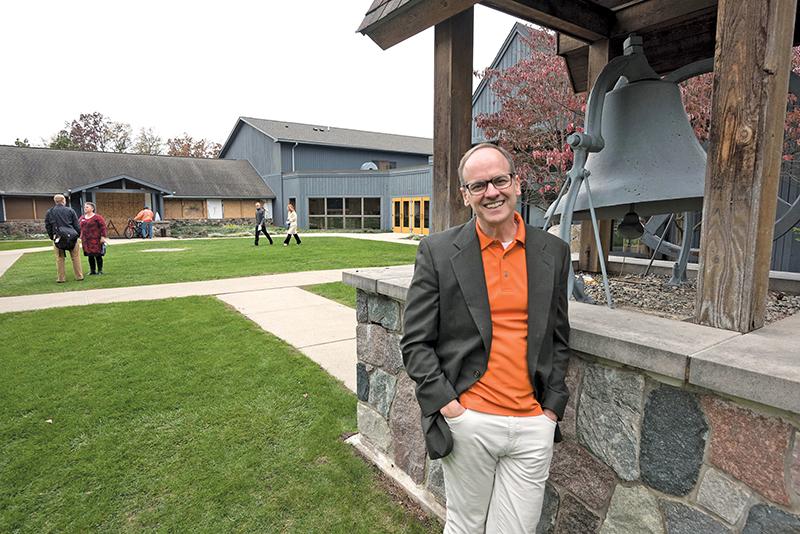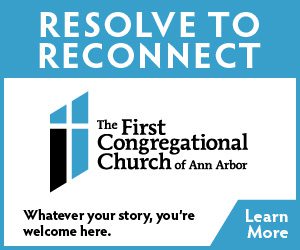“What more do we need to do for you? Have we offended you in any way?” the Rev. Dr. Matt Hook, pastor of the Dexter United Methodist Church, asked the Webster Township Planning Commission at the end of its October 18 meeting. The site plan and special use permit for the church’s planned expansion, first presented in April, were once again tabled for further review after impassioned discussions.
The church–this writer is a member–received township approval to expand ten years ago, but that project lapsed during the recession. This time around, the reception has been much chillier. Webster, fresh off contentious political and legal battles over party barns, is closely scrutinizing the church’s plans to build a multipurpose space, improvements to the sanctuary and interior traffic flow, new meeting rooms, and a three-story addition for education.
In September, five months after the planning commission first saw the site plan, planning commission chair Andrea Zamansky suggested that what the church classified as a multipurpose room should instead be regarded as an “amusement/entertainment/recreation facility.” That would require bigger setbacks, stricter noise management, and much more parking–475 spaces, she calculated, rather than the 259 the church architect proposed.
After the September meeting, with numbers for parking and setback requirements flying back and forth, the church hired Kalamazoo real estate attorney Matthew Van Dyk. At the October meeting, he told the planners that the church’s engineer looked at squeezing as many parking spaces as possible onto the church property, “covering every inch of green space.” Even doing that, he said, they’d be seventy-five short of the number Zamansky wanted. “We’d need to apply for construction of a parking deck if we went along with her requirement of 475 spaces,” Van Dyk said.
Between the September and October meetings, the definition of the multipurpose room was resolved amicably, as was a question about the addition’s setback. That left parking as the focus of the October session. Planning commissioners cited a 2014 report on the DUMC website that stated parking would become a “critical issue” in the future if the church continued to grow at its current rate. The commissioners pointed to the use of a church shuttle from the parking lot at the Dexter Mill as evidence that parking is a serious concern, noting that not only would the proposed addition provide a larger space to house potentially more people, but it would eliminate thirty of the 294 paved spaces currently on the site.
Church leaders responded that the rate of growth has been slower than they anticipated in 2014, and the shuttle is meant to keep spaces close to the building open for visitors. “Surely the commissioners must believe that we understand the importance of safe and accessible parking at the church,” Hook said. “The dispute and delays seem so unnecessary–and costly.”
“I’ve been to hundreds of planning commission meetings, and I have never seen anything like this,” Van Dyk told the commission at the close of the meeting. “I’ve seen far more objectionable clients with far more objectionable projects in other places, and they haven’t had these types of objections and problems. This is a church we’re talking about.”
Van Dyk’s presence was a sign that the church was thinking about its legal options: he’s an experienced litigator who last spring won a $575,000 settlement from the city of South Haven on behalf of a woman affected by an ordinance regulating short-term rentals. Churches have extra clout in zoning disputes, because federal law limits local governments’ power to regulate building projects by religious groups. In 2012, Pittsfield Township was sued for rejecting a planned new school for the Michigan Islamic Academy. Last year, the township’s insurer negotiated a settlement that approved a school even larger than the one Pittsfield had rejected–and paid MIA $1.7 million.
Zamansky emails that it’s the township’s policy “not to comment on matters involving pending applications.” Township supervisor John Kingsley echoed the statement. But at the October meeting, the planning commissioners didn’t budge. After nearly three hours of discussion, the church’s application was tabled once again.
—
Dexter United Methodist Church celebrates its 185th anniversary this year. Only twelve households existed in the village when Judge Samuel Dexter offered his home as the Methodists’ first meeting place. In the 1840s, he gave them land at Fourth and Central streets for a structure. (Their second church on that site now serves as a dental office.) Nearly 150 years later, in 1994, the entire congregation walked down the road and around the corner onto Huron River Dr., moving into the lodge of the former Boy Scout Camp Newkirk. After building their present sanctuary on the site in 1998, the lodge became the church’s fellowship hall.
The recession stymied their first plan to build new social and educational space. It was not until two years ago, when the congregation topped 1,000 members, that DUMC was able to launch a fundraising campaign that included plans for the addition.
“This was an opportunity to talk about generosity–of time and talents as well as treasure,” Hook says. “We called upon our congregation to bump up their generosity in all these areas by at least one level.”
The church hired a consulting firm specializing in church growth, which recommended a $4.5 million campaign to fund church operations, missions/restricted giving, and a building fund. The DUMC decided to aim for $4.85 million and kicked off the campaign on May 31, 2015. “We had a tremendous response that held steady throughout the next twenty-four months,” Hook says. “Eighty-eight percent of our folks contributed.” When it ended this May, the congregation had pledged $4.68 million. At the time, they hoped to start construction by the end of the summer.
Because the site is zoned for residential use, any change requires a variance. Even so, Hook admits that they were caught unprepared by the planning commissioners’ probing. At the commission’s September meeting, several of the church’s consultants were unavailable, leaving church leaders to try to provide answers to unexpected questions. “We weren’t at our best,” he says. But even with stepped-up efforts in October, the plan made little progress.
“This has been a learning curve on both sides,” church administrator Carl Espy suggests. “It’s partially because Webster has a relatively young commission; they’re looking at ordinances with fresh eyes, and they’re interpreting the code in a different way than our team does.”
—
After the September meeting, Hook reminded his congregation, “This situation can either divide us or unify us. We want you to know two things: first, that we’re working hard on getting approval for the building project, and secondly, the commissioners are not the enemy. They’re our neighbors, doing what is best … in their minds.” He paused and added, “Though I must admit, I’m kind of discouraged.”
He paused again and added a comment he has repeated often: “We’re a mission, not a monument. We’ll build in God’s time. Meanwhile, this glitch is not stopping our mission: Love God. Love People. Serve the World for Jesus Christ.”
Meanwhile, the old Newkirk Hall, the site of the proposed addition, stands deserted and empty, with plywood covering gaping holes once filled by windows. In August, expecting demolition to begin immediately, congregational members removed and stored the kitchen equipment off-site, completely gutted the interior, and donated all reusable materials to the local ReStore. And then they waited for township approval.
In October, they were still waiting. For the plans to become reality, the planning commission must first approve the site plan and recommend adoption by the township board of trustees. If the trustees agree, the plan will then be sent to the county, which must issue the necessary permits before demolition and construction can begin.
So far, DUMC’s plan has been stuck at that first step. But just before the Community Observer went to press, church officials and technical consultants met with Andrea Zamansky and Paul Zalucha, two of the eight township planning commission members, hoping to “find middle ground,” according to Espy.
“We told them we could find ten more [paved parking] spaces, bringing the number from 264 to 274, and we agreed to create an additional 20 gravel spaces, bringing the number to 294,” Espy says–not 475, but as many as the church has now. That change will require the church to revise its storm-water management plan; once the revised plan is approved by the county’s Water Resources Commission, the project will return to the planning commission.
“I’m optimistic we’ve closed the gap,” says Espy. “But we can’t be sure until we meet again on Nov. 15.”




